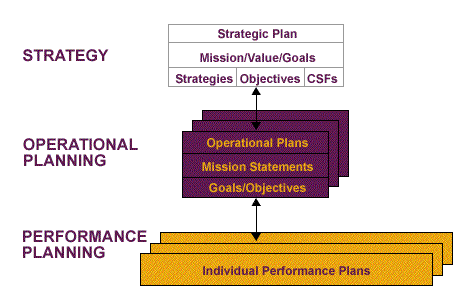Cascading the strategic plan is a process that filters down from the highest ranks to the lowest ranks. This means that the organisation’s strategic plan (long term) forms the basis of the business plan (short term). This, in turn, provides the basis for team and individual performance. An integrated performance management system should therefore be developed to ensure that each level of performance feeds into the next level efficiently.

A clearly-defined, top-down approach is required to ensure that individual goals and objectives tie in with team goals and objectives which, in turn, have to tie in with division goals and objectives, which are linked to the organisation's goals and objectives.
An organisation's performance planning typically occurs as four plans.
Strategic plan – performance requirements over the next 3-5 years.
Business plan – performance priorities for the next year.
Division/department/team plan – the role of these entities in achieving the goals in the business plan.
Individual performance plans – what each person (staff or manager) will achieve in the next year.
NOTE: Every lower-level plan must be aligned with and supportive of your organisation’s ambition.
As divisional/business unit head/supervisor you need to take the strategic drivers/objectives and convert it into a set of goals and objectives that will drive your division over the next 12 months. This process of formulating strategic objectives is often relatively simple. Management must ensure that the strategic objectives conform to the following appropriate attributes:
- Are they measurable (to allow the evaluation of performance in the future)?
- Are they acceptable to those in the organisation who must implement them?
- Are they flexible enough to allow for deviations from the original plan?
- Are they motivating?
- Are they consistent with each other?